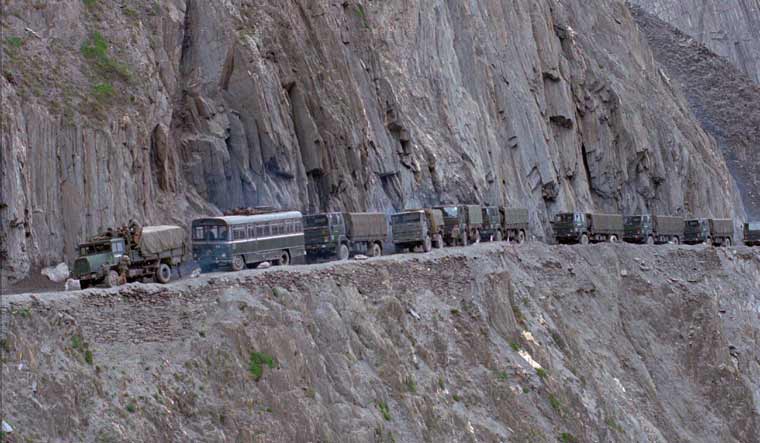India’s Covert Infrastructure: ‘Invisible’ Road to Boost Security at LAC

India’s Covert Infrastructure: ‘Invisible’ Road to Boost Security at LAC
In a strategic move aimed at bolstering national security along the Line of Actual Control (LAC), India is quietly constructing an ‘invisible’ road to its northernmost military outpost near the China border. This development, reported by Hindustan Times, signifies a significant enhancement in India’s military infrastructure, offering a safe and concealed passage for troops, weaponry, and logistical support. This article delves deeper into this clandestine road project, shedding light on its purpose, construction, and implications for India’s defense strategy.
The Covert Road to Daulat Beg Oldi
Nestled amidst the harsh terrains of Ladakh, Daulat Beg Oldi (DBO) is a strategically important military base situated at an altitude of approximately 17,000 feet. It lies close to the LAC, the de facto border between India and China, which has been a contentious region marked by periodic tensions and skirmishes. The construction of an ‘invisible’ road leading to DBO is a critical move that seeks to address various security concerns in this sensitive area.
The Purpose Behind the Project
The primary purpose of the ‘invisible’ road is to provide a secure and concealed route for the movement of Indian soldiers, equipment, and logistics to and from DBO. This remote outpost serves as a critical military base for India, given its proximity to the LAC and the ongoing border dispute with China. By improving access to DBO, India aims to enhance its military readiness in the region, ensuring a swift response to any potential security threats.
Construction of the Covert Road
The construction of this covert road project has been carried out with great care and precision to ensure that it remains hidden from prying eyes across the LAC. This involves techniques and materials that blend the road seamlessly into the natural landscape, making it nearly indistinguishable from the surrounding terrain. The road’s surface has been carefully designed to mimic the color and texture of the land, rendering it virtually invisible from a distance.
Additionally, the road has been constructed using advanced engineering methods, including the use of reinforced concrete, which is known for its durability and resilience in challenging environments. This ensures that the road can withstand the harsh weather conditions and challenging terrain of the region, allowing for year-round access to DBO.

Enhancing Security and Preparedness
The construction of the ‘invisible’ road holds several significant advantages for India’s security and military preparedness. Firstly, it ensures that troops and essential supplies can be rapidly deployed to DBO in times of need. This increased mobility is crucial for maintaining a strong defensive posture in the region.
Secondly, the road’s covert nature reduces the risk of detection and targeting by potential adversaries. In an area where heightened tensions persist, the ability to move troops and equipment discreetly is a strategic advantage that enhances India’s deterrence capabilities.
Moreover, the road’s construction showcases India’s commitment to securing its borders and defending its territorial integrity. It sends a clear message that India is prepared to invest in the necessary infrastructure to safeguard its interests in the region.
Diplomatic Considerations
While the construction of the ‘invisible’ road is primarily a military endeavor aimed at enhancing security, it is also a move that could have diplomatic implications. The LAC remains a contentious issue between India and China, with periodic border standoffs and negotiations. The presence of this covert road may serve as a reminder of India’s determination to protect its territorial claims and maintain a robust military presence along the border.
It is essential to note that India has consistently emphasized the need for a peaceful resolution to the border dispute through diplomatic means. The construction of the ‘invisible’ road does not signify an escalation of tensions but rather a pragmatic approach to ensure national security.

Environmental Impact
The construction of any infrastructure project in a sensitive region like Ladakh raises concerns about its environmental impact. India has been mindful of this aspect and has taken steps to minimize the ecological footprint of the road construction. Environmental assessments and mitigation measures have been put in place to preserve the fragile Himalayan ecosystem.
Conclusion
The construction of the ‘invisible’ road to Daulat Beg Oldi is a significant development in India’s efforts to bolster its national security along the Line of Actual Control. This covert road project, designed to be concealed from the China side of the border, serves the critical purpose of enhancing troop mobility, logistical support, and overall preparedness in the region.

While the road’s construction may have diplomatic implications, it primarily underscores India’s commitment to defending its borders and ensuring the security of its northernmost military outpost. As tensions along the LAC persist, the ‘invisible’ road stands as a symbol of India’s resolve to protect its territorial integrity while also emphasizing the importance of peaceful, diplomatic solutions to border disputes. As this project nears completion, it represents a significant milestone in India’s ongoing efforts to safeguard its national interests in the challenging terrain of Ladakh.






